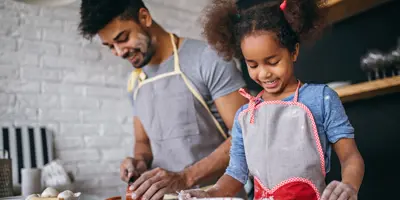6 човека одобряват
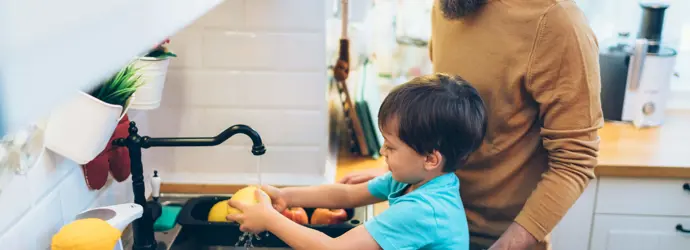
Children love to learn to cook and then scatter again, but it's all part of the fun. However, once they are old enough to be in flour up to the elbows, it's time to start teaching them basic food hygiene for children. Here are our 10 basic food hygiene rules for a fun, safe and hygienic kitchen.
1. Basic food hygiene: hand washing
Hand washing training before cooking is one of the most important rules of food hygiene. Explain to them that although there are good types of bacteria, there are some microbes that can harm them. That's why hands should be clean before eating, and before cooking, to make sure the whole family stays healthy.
Помогнете на децата да разберат концепцията за микробите, които покриват ръцете им с блясък. Помолете ги да измият целия блясък и им обяснете, че щом блясъкът е изчезнал, и микробите са изчезнали.
2. Change clothes
Turn food hygiene for children into play by dressing like a hygienic cook. Make sure your children's hair is tied, their sleeves are rolled up, all jewelry is moved, and that he or she is wearing an apron like a true professional. The chef's high hat is optional, but it is welcomed.
3. Clean then
Once your child understands the concept of germs, it will be easier for them to understand why it is important to wipe surfaces and clean after cooking. Involve your child in the cleaning process and show that the basic rules of food hygiene are fun by playing a game of "Because of it". Work as a team to wipe out spills with kitchen paper and clean germs from surfaces.
Съхранявайте абсорбираща кухненска хартия, като например Zewa, и я дръжте под ръка за изчистване на разливания. Тя е идеална и само за почистване, защото е достатъчно силнd, когато е мокра.
4. Separate the raw meat
Make sure your children know the difference between raw and cooked foods and why one of the most important rules of food hygiene is not to get confused, especially when it comes to raw meat. Explain to them that it contains bacteria that make you sick and that it weighs bacteria that can easily transfer to other foods nearby.
5. Use different cutting boards
Once children understand the rules of food hygiene associated with preserving raw meat, there will be no problem understanding why it is important to use different boards for different types of food. Invest in various colored cutting boards to remind them: red for raw meat, blue for raw fish, yellow for cooked meat, brown for vegetables, green for fruits and salads, and white for bread and dairy products.
6. Use towels when sneezing and coughing
Sneezing and coughing in a towel are good manners and an important rule of hygiene, especially when you are in the kitchen. Help children remember this always by keeping a box of soft Zewa towels in the kitchen so that they are constantly at hand.
7. How to arrange the refrigerator
Basic hygiene of food in the refrigerator is important to avoid food contamination. Teach your child how to safely arrange the refrigerator by asking them to take a picture of vegetarian tables, a picture of meat, and a picture of dairy products such as cheese or milk. Explain the differences between the types of food and that raw meat goes to the bottom shelf, vegetables in salad drawers and dairy products on top. Stick signs with these positions in front of the refrigerator to help them remember.
8. Do not lick your fingers
Licking the fingers is one of the rules of food hygiene, which is too tempting to break - even by the mother and father. If you're baking a cake, encourage your child to use spoons to taste the cake mixture and stop putting the licked spoon back into the mixture. Keep kitchen paper on hand to wipe sticky fingers and reduce the temptation to lick them.
9. Proper cooking
This is a great time to teach your child why cooking makes a particular food safe to eat and how different recipes require different durations in cooking time. A fun way to illustrate this is with a food thermometer show them how the temperature rises and at what temperature the food is safe to eat.
10. How to store food
Teach your child that different types of food should be stored at different temperatures. For example, lentils should be stored in a cabinet, milk in the refrigerator, and frozen vegetables in the freezer. Teaching food hygiene to children should also be about having fun, so meanwhile help them decorate some jars for dry food to store in.
Cooking is an important skill for all boys and girls that they need to learn, but it must also ensure that they understand the basic rules of food hygiene, which is equally important. Once they master the basic hygiene of food, you can enjoy their masterful creations with the peace of mind that they are safe to eat.
Свързани статии
Как най-лесно да почистим хладилника
Нашия наръчник за усърдно почистване на хладилници за по-малко от 30 минути. Кликнете тук за да се включите в приключението!
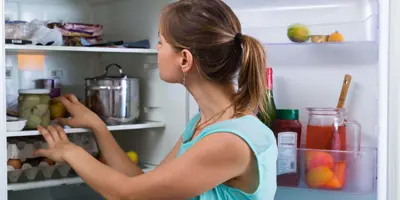
3 лесни начина за стерилизиране на буркани за сладко
Открийте 3 лесни за стерилизиране на буркани за конфитюр, включително как да стерилизирате буркани във фурната, в микровълнова печка и в съдомиялна машина.
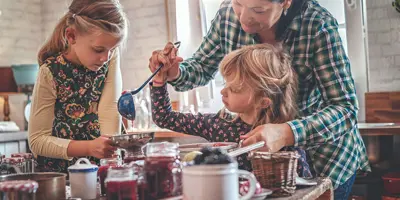
Две идеи за забавен рожден ден с плодове
Търсите рецепти за здравословна храна за деца за парти? Вижте нашите плодови сладкиши и още идеи за забавен рожден ден!

Как да направим солено тесто за деца
Имате време за забавление с вашите деца, като направите солено тесто и да бъдете творчески настроени с тези идеи за соленото тесто. Прочетете за една проста рецепта
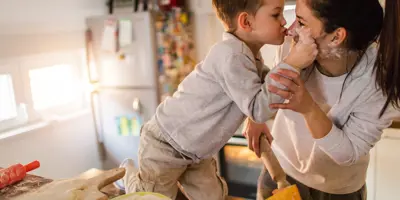
5 фантастични идеи за семеен пикник
Вдъхновете се от нашите 5 забавни идеи за храна за семеен пикник от вкусни кифлички до питки и десерти.

2 лесни рецепти за деца с 5 или по-малко съставки
Огледайте се за лесни и бързи рецепти, които децата могат да правят сами? Прочетете, за да откриете 2 лесни рецепти за деца с 5 или по малко съставки
